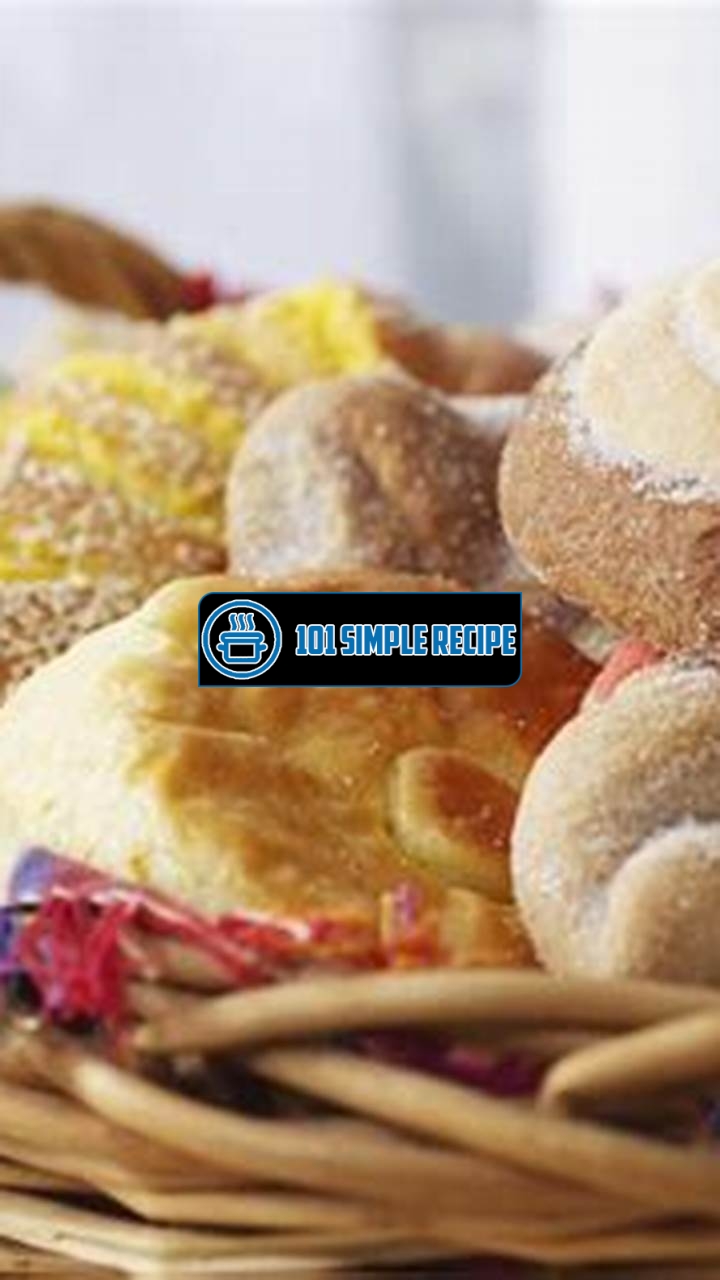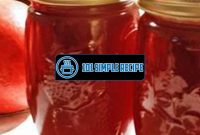Are you a fan of sweet and fluffy pastries? Look no further! Today, we present to you a delightful recipe for Pan Dulce, a traditional Mexican sweet bread that will leave your taste buds craving more. This step-by-step guide will walk you through the process of creating this delectable treat, ensuring that you achieve bakery-quality results right in your own kitchen. So, roll up your sleeves, put on your apron, and let’s get started on this delicious Pan Dulce adventure!

The History of Pan Dulce
Discover the origins and cultural significance of this traditional Mexican sweet bread.
Ancient Influence on Pan Dulce
Pan dulce, also known as Mexican sweet bread, holds a rich history that stretches back centuries. The origins of this delectable treat can be traced back to ancient civilizations that inhabited the region that is now known as Mexico. The Aztec and Mayan cultures greatly influenced the development of pan dulce.
The ancient civilizations utilized maize as a staple ingredient in their cuisine. Maize was ground and used to make various food items, including a type of bread that closely resembled modern-day pan dulce. These early versions of sweet bread were often flavored with honey, fruits, and spices to enhance their taste.
The ancient influence on pan dulce can still be seen today in the traditional ingredients used to make this beloved treat.
The Arrival of Pan Dulce in Mexico
The arrival of pan dulce in Mexico can be attributed to Spanish conquerors. When the Spanish arrived in Mexico in the 16th century, they brought with them their culinary traditions and recipes. The Spanish brought wheat flour, yeast, and butter, which were essential ingredients in the production of pan dulce.
The Spanish influence led to the evolution of pan dulce, as the indigenous people of Mexico began incorporating these new ingredients into their traditional recipes. Over time, pan dulce became a staple in Mexican cuisine, often enjoyed during celebrations, holidays, and everyday meals.
The arrival of pan dulce in Mexico marked a significant turning point in the history of this beloved sweet bread, as it became deeply ingrained in Mexican culture.
Regional Varieties of Pan Dulce
Mexico boasts a diverse culinary landscape, and this is reflected in the regional varieties of pan dulce that can be found throughout the country. Each region puts its own unique twist on this traditional treat.
- Concha: This iconic pan dulce features a sweet roll topped with a crumbly, sugar crust that resembles a seashell. It is a favorite among Mexicans and visitors alike.
- Puerquito: Also known as “piggy cookies,” puerquitos are shaped like little pigs and are often flavored with cinnamon. They are popular during the Christmas season.
- Oreja: This pan dulce is shaped like an ear and is flaky and layered. It is typically sprinkled with sugar and cinnamon.
- Empanada: Another beloved variety, empanadas are filled with a sweet filling such as fruit or custard. They can be baked or fried.
Each region’s unique ingredients, flavors, and techniques contribute to the wide array of pan dulce varieties available in Mexico.
Whether you prefer the softness of a concha or the crunchiness of an oreja, pan dulce is a delightful treat that embodies the rich history and cultural heritage of Mexico.
Coca Cola cake recipe is a unique and tasty dessert that you have to try. It’s made with Coca Cola and has a rich and moist texture. Give it a try and you won’t be disappointed!
Ingredients and Tools for Making Pan Dulce
Are you ready to embark on a culinary adventure and create your own delicious pan dulce at home? Before you get started, it’s important to gather all the necessary ingredients and tools. In this guide, we will explore the key components and equipment needed to make this mouthwatering treat. Let’s dive in!
Essential Ingredients for Pan Dulce
To create authentic pan dulce, you will need the following essential ingredients:
- All-Purpose Flour: This is the base of the dough and provides structure and texture to the sweet bread.
- Active Dry Yeast: Yeast is responsible for the rise and fluffy texture of the pan dulce.
- Sugar: A sweetener that adds flavor and balances the other ingredients.
- Butter: Butter enriches the dough and gives it a tender and rich taste.
- Milk: Milk adds moisture to the dough and contributes to its softness.
- Eggs: Eggs provide structure and help bind the ingredients together.
- Salt: A pinch of salt enhances the flavor of the pan dulce.
Note: Feel free to experiment with different types of sugar, such as brown sugar or honey, to add a unique twist to your pan dulce.
Specialized Tools for Pan Dulce
While the ingredients are essential, having the right tools will make the process of making pan dulce much easier and more enjoyable. Here are some specialized tools you may need:
- Mixing Bowl: A large mixing bowl will be your best friend throughout the dough preparation process.
- Whisk or Electric Mixer: These tools will help you combine the ingredients thoroughly and create a smooth dough.
- Baking Sheets: Perfectly sized baking sheets are necessary to accommodate the various shapes and sizes of pan dulce.
- Bread Pans: If you prefer a loaf-style pan dulce, investing in quality bread pans is a must.
- Parchment Paper: To prevent the pan dulce from sticking to the baking sheets, line them with parchment paper.
- Pastry Brush: This handy tool is used to brush melted butter or egg wash over the pan dulce for a beautiful golden crust.
- Sharp Knife or Scissors: These tools are essential for creating the iconic cuts and designs on top of the pan dulce.
Note: Depending on the specific recipe and design you choose, you may also need molds or special cutters for shaping the pan dulce.
Optional Ingredients for Flavor Variations
If you want to add a personal touch to your pan dulce, here are some optional ingredients you can experiment with:
- Vanilla Extract: Add a few drops of vanilla extract to enhance the flavor of the pan dulce.
- Cocoa Powder or Chocolate Chips: For chocolate lovers, incorporating cocoa powder or chocolate chips can create a delightful twist.
- Fruit Fillings: Inject bursts of fruity goodness into your pan dulce by using canned or homemade fruit fillings.
- Nuts or Raisins: For added texture and flavor, consider sprinkling nuts or raisins on top of the dough before baking.
- Confectioners’ Sugar Glaze: Drizzling a sweet glaze over the pan dulce can give it an extra touch of decadence.
Now that you have a comprehensive list of ingredients and tools, you are equipped to embark on your pan dulce-making journey. Get ready to create a batch of these soft and delicious pastries that will surely impress your family and friends!
The Art of Preparing Pan Dulce
Pan dulce, also known as sweet bread, is a traditional Mexican pastry that is loved by people all over the world. This delightful treat is characterized by its fluffy texture, sweet flavors, and beautiful decorations. If you’re craving a taste of this delicious pastry, why not try making it yourself? In this article, we will guide you through the process of preparing pan dulce from scratch, so you can enjoy the satisfaction of creating a homemade treat.
Pan Dulce Dough Preparation
The first step in creating your pan dulce masterpiece is preparing the dough. The dough serves as the foundation for the sweet bread, giving it its soft and fluffy texture. Here’s a step-by-step guide to help you get started:
- Mix the dry ingredients: In a large bowl, combine flour, sugar, salt, and yeast. Mix them well using a whisk or a fork. This will ensure that all the ingredients are evenly distributed.
- Add the wet ingredients: Create a well in the center of the dry mixture and pour in warm milk, melted butter, and beaten eggs. Use a wooden spoon or your hands to mix everything together until a soft dough forms.
- Knead the dough: Transfer the dough onto a floured surface and knead it for about 10 minutes. Kneading helps develop the gluten in the dough, resulting in a lighter and more elastic texture.
- Let the dough rise: Place the kneaded dough in a lightly greased bowl and cover it with a clean kitchen towel. Allow it to rise for about 1-2 hours, or until it doubles in size. This step is crucial for achieving a fluffy and airy pan dulce.
Shaping and Decorating Pan Dulce
Once the dough has risen, it’s time to shape and decorate your pan dulce. This is where you can let your creativity shine and add a personal touch to your sweet bread. Follow these steps to bring your pan dulce to life:
- Divide the dough: Punch down the risen dough to release any air bubbles. Then, divide the dough into smaller portions, depending on the shapes and sizes you desire for your pan dulce.
- Create shapes: Take each portion of dough and shape it into balls, cones, or any other shape you prefer. You can even use cookie cutters for more intricate designs. The sky is the limit!
- Add toppings: To make your pan dulce even more enticing, add toppings such as sprinkles, colored sugar, or crushed nuts. These decorative elements not only add visual appeal but also enhance the overall flavor.
Baking and Finishing Touches
After all the shaping and decorating, it’s time to bake your pan dulce to golden perfection. Here’s what you need to do:
- Preheat the oven: Set your oven to the appropriate temperature, usually around 350°F (180°C). Preheating ensures that the pan dulce bakes evenly and retains its shape.
- Bake the pan dulce: Place your shaped and decorated pan dulce on a parchment-lined baking sheet. Bake them for about 15-20 minutes, or until they turn golden brown. The wonderful aroma of freshly baked sweet bread will fill your kitchen!
- Cool and enjoy: Once the pan dulce is baked, allow it to cool on a wire rack. This will prevent the bottoms from becoming soggy. Once they have cooled down, grab a cup of coffee or hot chocolate and indulge in the delightful flavors of your homemade pan dulce.
Now that you know the secrets of preparing perfect pan dulce, it’s time to roll up your sleeves and start baking. With a little practice and a touch of creativity, you’ll be able to create beautiful and delicious pan dulce that will impress your family and friends. So go ahead, embrace the art of pan dulce making and savor the sweet rewards!
Chapli kabab recipe is a popular Pakistani dish that is full of flavor. It’s made with ground meat and a blend of spices, and it’s perfect for a delicious and satisfying dinner. Give it a try and you’ll love it!
Flavorful Pan Dulce Varieties
When it comes to pan dulce, the possibilities are endless. From sweet to savory, there is a wide range of flavors and fillings that can be found in different types of this delicious Mexican pastry. Whether you have a sweet tooth or prefer something more savory, there is a pan dulce variety that will satisfy your cravings.
Sweet Pan Dulce Varieties
One of the most popular types of sweet pan dulce is called Conchas. These sweet bread rolls are characterized by their unique shell pattern on top, which is made with a sugar paste. The soft and fluffy texture of Conchas pairs perfectly with a hot cup of coffee or hot chocolate.
Polvorones are another beloved sweet pan dulce variety. These crumbly cookies are made with a combination of flour, sugar, and butter. They often come in different flavors such as vanilla, cinnamon, or chocolate. Polvorones are perfect for enjoying as a snack or for dipping into your favorite beverage.
Pan de Muerto, or Bread of the Dead, is a sweet pan dulce variety that is traditionally enjoyed during the Mexican holiday, Day of the Dead. This round loaf of bread is flavored with orange blossom water and topped with sugar. The decorative bone shapes on top represent the deceased and make it a visually striking pastry.
Savory Pan Dulce Varieties
If you prefer something more savory, there are also plenty of options to choose from. One popular savory pan dulce variety is called Puerquitos, or Piggy Cookies. These pig-shaped cookies are made with molasses, cinnamon, and other spices, giving them a rich and flavorful taste. Puerquitos are often enjoyed alongside a warm cup of milk.
Teleras are another savory pan dulce variety that is perfect for making sandwiches. These soft bread rolls have a slightly crisp crust and a fluffy interior, making them the ideal vehicle for any filling you desire. Whether you prefer traditional sandwich ingredients or something more adventurous, Teleras are a versatile option.
Pan de Bistec is a savory pan dulce variety that is filled with seasoned meat, typically beef. The bread is soft and slightly sweet, providing the perfect balance to the savory filling. Pan de Bistec is often enjoyed as a hearty snack or as part of a larger meal.
Regional and Specialty Pan Dulce
In addition to the classic flavors, different regions in Mexico have their own unique pan dulce specialties. For example, in the state of Oaxaca, you can find a pan dulce variety called Empanadas de Leche. These pastries are filled with a sweet milk-based filling and are often enjoyed as a breakfast treat.
Another regional specialty is the Marranito, which is a pig-shaped pan dulce popular in the state of Puebla. These gingerbread-like cookies are made with molasses, giving them a rich and slightly spicy flavor. The adorable pig shape makes them a hit with both kids and adults alike.
There are many more regional and specialty pan dulce varieties to explore and enjoy. Whether you’re a fan of the classic flavors or curious about trying something new, pan dulce offers a delightful culinary adventure.
Pan dulce recipe is a delicious and traditional Mexican sweet bread. If you’re looking for a tasty dessert to try, this recipe is a must-try!
Serving and Enjoying Pan Dulce
When it comes to serving and savoring pan dulce, there are several cultural practices and tips that can enhance your experience. The delightful aroma and sweet flavors of this Mexican pastry make it a favorite treat for people of all ages. Whether you are hosting a gathering or simply enjoying a quiet afternoon at home, here are some suggestions to ensure you make the most of your pan dulce:
✨
Traditional Pan Dulce Presentation
In Mexican culture, pan dulce is often showcased in an enticing display. To create an authentic presentation, arrange the pan dulce in a colorful and inviting pattern. Using a decorative tray or basket, place the pastries at the center and surround them with vibrant linens or tissue paper. The visual appeal of the display adds to the overall experience and sets the mood for indulgence. Don’t forget to include a variety of shapes and flavors to cater to different preferences.
Pairing Pan Dulce with Beverages
Choosing the right beverage to pair with your pan dulce can elevate your enjoyment. Mexican hot chocolate is a classic option that complements the sweetness of the pastry with its rich and creamy texture. The warm and comforting combination is perfect for cooler months. Coffee, both hot and cold, is another popular choice. Brew a strong cup of coffee to balance the sweetness, or prepare a refreshing iced coffee to enjoy during warm days. Remember, the goal is to enhance the flavors without overpowering them.
☕
For those seeking a non-caffeinated option, a glass of milk or horchata, a traditional Mexican rice-based drink, can also be delightful. The smoothness of the milk or the subtle cinnamon flavors of horchata provide a refreshing contrast to the sweetness of pan dulce.
Pan Dulce in Celebrations and Festivities
Pan dulce plays a significant role in Mexican celebrations and festivities. It is often served during holidays such as Día de los Muertos (Day of the Dead) and Christmas. In these occasions, the pan dulce is not only enjoyed as a treat but also holds symbolic meaning. Sharing pan dulce with loved ones is a way to honor and remember those who have passed.
In addition to holidays, pan dulce is a staple in birthday parties and other special events. Instead of a traditional cake, some people opt for a tower of pan dulce adorned with candles. This unique presentation adds a festive touch and allows guests to try different flavors throughout the celebration.
Overall, serving and enjoying pan dulce is a joyful experience that can be enhanced by cultural practices and thoughtful pairings. Whether you are presenting it in a traditional manner, selecting the perfect beverage, or incorporating it into celebrations, pan dulce is a delightful treat that brings people together.
Frequently Asked Questions
Thank you for taking the time to read our article on pan dulce recipe! We hope you found it informative and inspiring. If you have any further questions, feel free to check out the FAQs below.
| No. | Questions | Answers |
|---|---|---|
| 1. | What is pan dulce? | Pan dulce is a traditional Mexican sweet bread that comes in various shapes, sizes, and flavors. It is often enjoyed with a cup of hot chocolate or coffee. |
| 2. | How long does it take to make pan dulce? | The preparation and baking time for pan dulce can vary depending on the specific recipe. On average, it takes about 2-3 hours from start to finish. |
| 3. | What are the key ingredients for pan dulce? | The main ingredients for pan dulce include flour, sugar, eggs, butter, yeast, and various flavorings such as vanilla or citrus zest. |
| 4. | Can I customize the toppings and fillings for pan dulce? | Absolutely! One of the fun parts of making pan dulce is the ability to experiment with different toppings and fillings. Popular options include sugar glaze, sprinkles, and various sweet fillings like chocolate or fruit jam. |
| 5. | What are some common variations of pan dulce? | There are countless variations of pan dulce, each with its own unique flavor and design. Some popular variations include conchas (shell-shaped bread), orejas (palmiers), and cuernos (horns). |
| 6. | Can I freeze pan dulce? | Yes, you can freeze pan dulce for later enjoyment. Just make sure to wrap it tightly in plastic wrap or place it in an airtight container to prevent freezer burn. |
Happy Baking and We Hope to See You Again!
Thank you once again for reading our article on pan dulce recipe. We hope you feel inspired to try making this delicious Mexican sweet bread in your own kitchen. Remember to bookmark our page or subscribe to our newsletter to stay updated with more tasty recipes and culinary tips. Happy baking, and we look forward to seeing you again soon!
Jump to Recipe
Pan Dulce Recipe

Learn how to make authentic pan dulce at home with this easy recipe. Perfectly sweet and fluffy, these Mexican sweet breads are a delight for any occasion.
- 3 cups all-purpose flour
- 1/2 cup granulated sugar
- 1/4 cup unsalted butter (softened)
- 1/4 cup warm milk
- 2 eggs
- 2 teaspoons active dry yeast
- 1 teaspoon vanilla extract
- 1/2 teaspoon salt
- 1/4 teaspoon ground cinnamon
- In a small bowl, dissolve the yeast in warm milk with a teaspoon of sugar. Let it sit for 5-10 minutes until frothy.
- In a large mixing bowl, combine the flour, sugar, salt, ground cinnamon, and softened butter. Add the activated yeast mixture and eggs. Mix well until a soft dough forms. Knead the dough for about 5 minutes until it becomes smooth and elastic.
- Place the dough in a greased bowl, cover it with a clean kitchen towel, and let it rise in a warm place for about 1 hour or until it doubles in size.
- Once the dough has risen, punch it down to release any air bubbles. Divide the dough into small portions and shape them into your desired pan dulce designs. Place the shaped dough onto a baking sheet lined with parchment paper.
- Cover the shaped dough with a clean kitchen towel and let it rise for another 30 minutes.
- Preheat the oven to 350°F (175°C). Bake the pan dulce for 15-20 minutes or until they turn golden brown.
- Allow the pan dulce to cool slightly before serving. They are best enjoyed fresh, but you can store them in an airtight container for up to 3 days.






